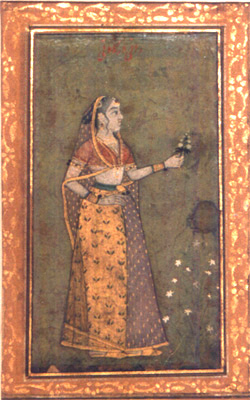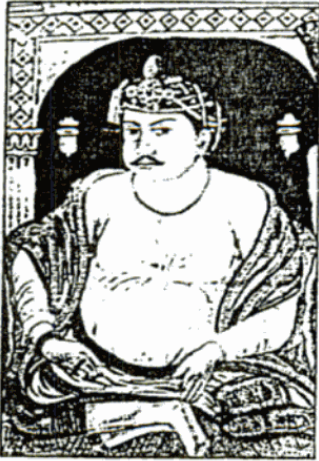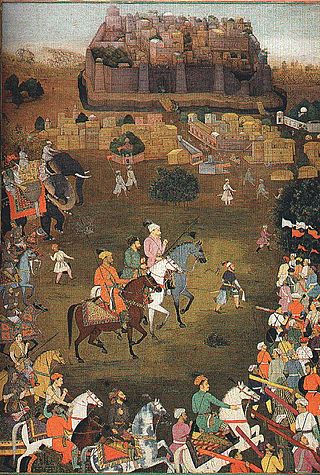Related Research Articles

Gondwana, also known as Gondaranya, the land of Gondwana, is a region of India named after the Gondi people who live there. The name of the ancient continent of Gondwanaland was derived from Gondwana, because some of the earliest rock formations of this continent were first investigated in part of the region in modern Odisha.

Jabalpur, formerly Jubbulpore, is a city situated on the banks of Narmada River in the state of Madhya Pradesh, India. It is the third-largest urban agglomeration of the state and the 38th-largest of the country. Jabalpur is the administrative headquarters of the Jabalpur district and the Jabalpur division. It is the judicial capital of Madhya Pradesh as the Madhya Pradesh High Court is located in the city. It is generally accepted that the game of snooker originated in Jabalpur. Jabalpur is also the railway headquarters of the West Central Railway. Jabalpur Cantonment is one of the largest cantonments in India and houses the army headquarters of five states. The city is known for the marble rocks on the river Narmada at Bhedaghat.

The Gondi (Gōṇḍī) or Gond people, who refer to themselves as "Koitur", are an ethnolinguistic group in India. Their native language, Gondi, belongs to the Dravidian family. They are spread over the states of Madhya Pradesh, Maharashtra, Chhattisgarh, Uttar Pradesh, Telangana, Andhra Pradesh, Bihar, and Odisha. They are listed as a Scheduled Tribe for the purpose of India's system of reservation.
Mandla is a city with municipality in Mandla district in the Indian state of Madhya Pradesh. It is the administrative headquarters of Mandla District. The city is situated in a loop of the Narmada River, which surrounds it on three sides, and for 15 miles between Mandla and Ramnagar, Madhya Pradesh the river flows in a deep bed unbroken by rocks. The Narmada is worshiped here, and many ghats have been constructed on the banks of the river. It was a capital of the Gondwana Kingdom who built a palace and a fort, which in the absence of proper care have gone to ruins.

Tikamgarh is a town and a tehsil in Tikamgarh district in the Indian state of Madhya Pradesh. The city serves as a district headquarters. The earlier name of Tikamgarh was Tehri consisting of three hamlets, forming a rough triangle. In Tikamgarh town there is locality still known as 'Purani Tehri'. Until Indian independence in 1947, Tikamgarh, formerly called Tehri, was part of the kingdom of Orchha, which was founded in the 16th century by the Bundeli chief Rudra Pratap Singh, who became the first King of Orchha. In 1783 the capital of the state was moved to Tehri, about 40 miles (64 km) south of Orchha, which was home to the fort of Tikamgarh, and the town eventually took the name of the fort. The district is famous for the old fort of Kundar known as Garh Kundar, which was built by Khangars and remained the capital of Khangar rulers from 1180 to 1347.

Tikamgarh district is one of the 52 districts of Madhya Pradesh state in central India. Tikamgarh town is the district headquarters. The district is part of Sagar Division.
Erich is a town and a nagar panchayat in Jhansi district in the state of Uttar Pradesh, India. In ancient period it was known as Erikachha or Erakachha and according to a Buddhist text, the Petavatthu it was one of the major cities of the Dasanna janapada.

Rani Durgavati was the queen regent of Gondwana in 1550–1564 AD. She got married to King Dalpat Shah, the son of King Sangram Shah of Gondwana. She served as regent of Gondwana during the minority of her son, Vir Narayan, from 1550 until 1564. She is chiefly remembered for defending Gondwana against the Mughal Empire.
The Rajgonds are the ruling class of the Gonds. The region of Gondwana consisted of neighbouring kingdoms. To the south was the Kingdom of Chanda and to the north was the powerful Garha-Mandla kingdom. In the 16th century, the Kingdom of Deogarh rose as a powerful state with the Kherla Kingdom in its western past.

Orchha State was a kingdom situated in the Bundelkhand region and later a princely state in British India. The state was ruled by Bundela clan of Rajputs. It was located within what is now the state of Madhya Pradesh.
Raja Sangram Shah Madavi was a king of the Garha Kingdom of Gondwana, in the state of Madhya Pradesh, India. Raja Sangram Shah, who belonged to the Gond Dynasty in central India, was the 48th and most well known ruler of the dynasty, and during his reign he had conquered 52 forts to strengthen his kingdom. The Chouragarh Fort in Narsinghpur was built in his honour for conquering 52 forts.

Bakht Buland Shah was a ruler of the Rajgond dynasty. He added to his kingdom, the territories of Chanda and Mandla, and portions of Nagpur, Balaghat, Seoni, Bhandara and the adjoining Rajput kingdom of Kherla/Khedla. The present districts of Chhindwara and Betul also fell under his control. A great warrior, he went on to conquer Pauni, Dongartal, Sivni, and Katangi.

Raja Jhujhar Singh Ju Deo was the Bundela ruler of Orchha Kingdom in the 17th century reining from 1627 to 1635 in the cultural Bundelkhand region of modern Madhya Pradesh.
The Gondwana Kingdoms were the ruling kingdoms in the Gondwana region of India. The Gondwana region includes the core region of the eastern part of the Vidarbha of Maharashtra, Garha Kingdom, the parts of Madhya Pradesh immediately to the north of it, and parts of westerm Chhattisgarh. The wider region extends beyond these, also including parts of northern Telangana, western Odisha and southern Uttar Pradesh.
The Garha Kingdom, also called Garha Mandla or Garha Katanga, was an early-modern-era kingdom in India. It was the first large kingdom to be founded by the Gond tribe and dominated much of Central India at its peak.
Dalpat Shah was the 49th ruler of the Garha Kingdom, which controlled the Indian region of Gondwana. His reign was short, he died in 1550, leaving the kingdom in the hands of his able wife Rani Durgavati, acting as a regent for their son Vir Narayan.

The Gonds of Deogarh were a Gond royal house that ruled large parts of the Vidarbha region and parts of present-day southern Madhya Pradesh. Their Kingdom consisted of the area which later became the Nagpur Kingdom. They made Nagpur region a prosperous and plentiful kingdom, founding the city of Nagpur and building further infrastructure. However, internal bickering led to their decline and they were practically made state pensioneries by the Maratha general Raghoji I Bhonsle in the 1743.
The Kingdom of Chanda was one of the main Gond kingdoms, ruling parts of central India. In 1751, it was conquered by the Maratha ruler of Nagpur, Raghoji I Bhonsle.
The Saugor subha was a province of the Maratha Empire comprising the central Indian territories of the Peshwa or prime minister. It was ruled by hereditary Maratha Pandit governors who had their headquarters at the city of Sagar.

The siege of Orchha was a military expedition of Mughal empire under Aurangzeb aganist rebellious Bundela Rajputs under Jhuhar Singh.The Mughal army captured the Bundela capital during the combined siege of Orchha, on October 4, 1635. Aurangzeb raised the Mughal flag on the highest terrace of the Jahangir Mahal and installed Devi Singh as the new administrator, while Jhujhar Singh escaped.
References
- 1 2 3 Sharma, Anima (2005). Tribe in transition : a study of Thakur Gonds (1st ed.). New Delhi: Mittal Publications. ISBN 9788170999898.
- 1 2 3 4 5 Chatterton, Eyre (8 January 2021). The Story Of Gondwana. Read Books Ltd. ISBN 978-1-5287-6963-1.
- ↑ Bundelkhand), Hirde Sah (King of (1976). Hridaya prakash of Hirde Sah (in Hindi). Shri Prannath Mission.
- ↑ Jani, Dr Kalpesh (2 June 2019). Sangeet Aarohee - An Essential Study of Hindustani Classical Music. BecomeShakespeare.com. ISBN 978-93-88930-36-9.
- ↑ Ashtaputre, Meghana (14 August 2021). 'Raas' : The Mandal Raas of Mulher Province of Maharashtra. Blue Rose Publishers.
- 1 2 Orissa District Gazetteers: Mandla. Superintendent, Orissa Government Press. 1995.
- 1 2 "The Gond kingdoms". downtoearth.
- 1 2 Deogaonkar, Shashishekhar Gopal (2007). The Gonds of Vidarbha. Concept Publishing Company. ISBN 978-81-8069-474-5.
- 1 2 Medieval PERIOD (Complete History of Nagpur). 16 July 2021.
{{cite book}}:|website=ignored (help) - ↑ "Untold True Story of a king Who Had 16 Pet Tigers". www.patrika.com. Retrieved 12 December 2020.
- ↑ "Five-storey palace built from 350 year old stones". www.naidunia.com. Retrieved 12 December 2020.
- The great Gondi shahs (retold), 2008, G.H. Stein (original author- Kartabhanu), Motilal Banarsidass Publishers